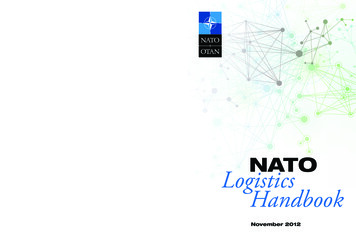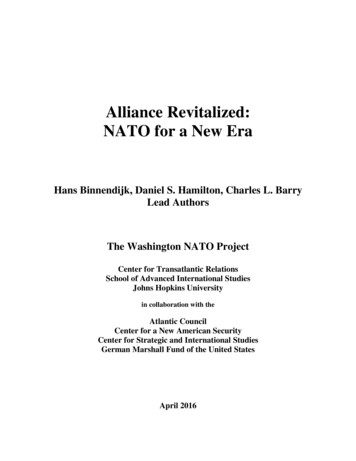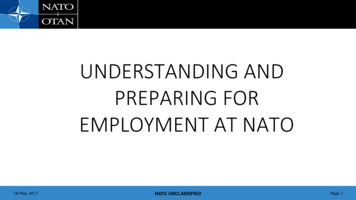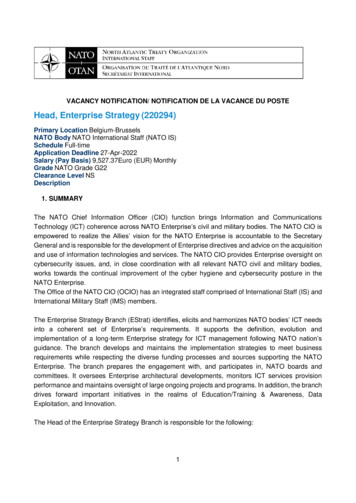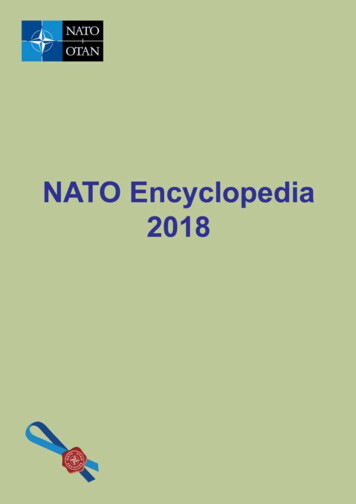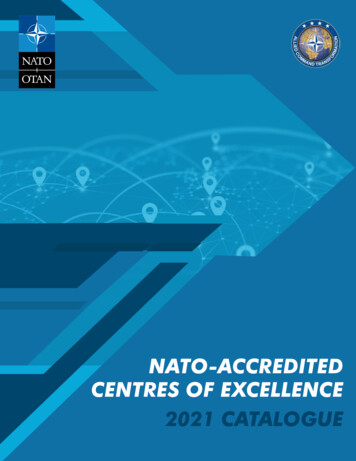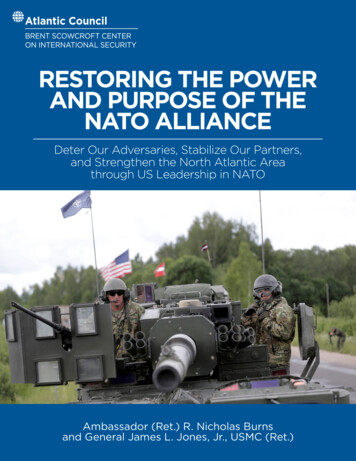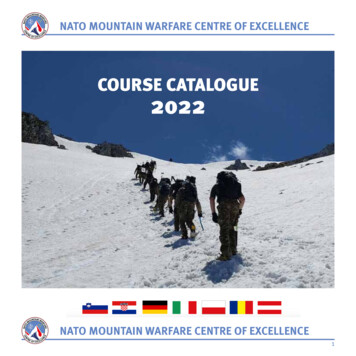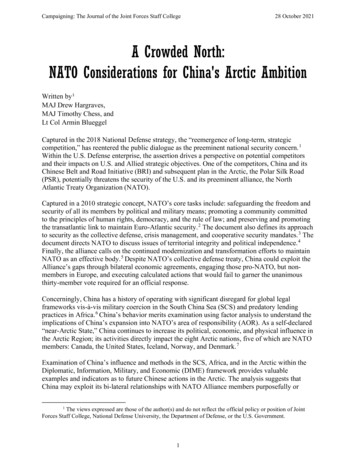
Transcription
Campaigning: The Journal of the Joint Forces Staff College28 October 2021A Crowded North:NATO Considerations for China's Arctic AmbitionWritten by 1MAJ Drew Hargraves,MAJ Timothy Chess, andLt Col Armin BlueggelCaptured in the 2018 National Defense strategy, the “reemergence of long-term, strategiccompetition,” has reentered the public dialogue as the preeminent national security concern. 1Within the U.S. Defense enterprise, the assertion drives a perspective on potential competitorsand their impacts on U.S. and Allied strategic objectives. One of the competitors, China and itsChinese Belt and Road Initiative (BRI) and subsequent plan in the Arctic, the Polar Silk Road(PSR), potentially threatens the security of the U.S. and its preeminent alliance, the NorthAtlantic Treaty Organization (NATO).Captured in a 2010 strategic concept, NATO’s core tasks include: safeguarding the freedom andsecurity of all its members by political and military means; promoting a community committedto the principles of human rights, democracy, and the rule of law; and preserving and promotingthe transatlantic link to maintain Euro-Atlantic security. 2 The document also defines its approachto security as the collective defense, crisis management, and cooperative security mandates. 3 Thedocument directs NATO to discuss issues of territorial integrity and political independence. 4Finally, the alliance calls on the continued modernization and transformation efforts to maintainNATO as an effective body. 5 Despite NATO’s collective defense treaty, China could exploit theAlliance’s gaps through bilateral economic agreements, engaging those pro-NATO, but nonmembers in Europe, and executing calculated actions that would fail to garner the unanimousthirty-member vote required for an official response.Concerningly, China has a history of operating with significant disregard for global legalframeworks vis-à-vis military coercion in the South China Sea (SCS) and predatory lendingpractices in Africa. 6 China’s behavior merits examination using factor analysis to understand theimplications of China’s expansion into NATO’s area of responsibility (AOR). As a self-declared“near-Arctic State,” China continues to increase its political, economic, and physical influence inthe Arctic Region; its activities directly impact the eight Arctic nations, five of which are NATOmembers: Canada, the United States, Iceland, Norway, and Denmark. 7Examination of China’s influence and methods in the SCS, Africa, and in the Arctic within theDiplomatic, Information, Military, and Economic (DIME) framework provides valuableexamples and indicators as to future Chinese actions in the Arctic. The analysis suggests thatChina may exploit its bi-lateral relationships with NATO Alliance members purposefully orThe views expressed are those of the author(s) and do not reflect the official policy or position of JointForces Staff College, National Defense University, the Department of Defense, or the U.S. Government.11
Campaigning: The Journal of the Joint Forces Staff College28 October 2021inadvertently undermine NATO security interests in the region. China may also look to fillseams between both NATO members and enhanced partners (Finland and Sweden), usingeconomic and diplomatic influence to shape their relationship with NATO. More broadly,China’s increased presence in the Arctic Region can generally be viewed as an extension ofactions in other geographical domains and may indicate the effects the PSR may have onNATO’s security.Belt and Road Initiative BackgroundChina’s economic growth has fueled its global expansion. Since the early 1990s, China’sincreasingly deep purse has allowed it to impress its national goals on the world and achieve anincreasing level of influence as it expands outward. China unveiled its BRI in 2013, as a grandplan to connect trade partners from Asia, Africa, and Europe, and expand opportunities forChinese influence and exports. 8 The plan seeks to establish two routes, an overland routethrough the heart of Asia and a maritime route that follows established sea transportation routes.China’s ambitious plan includes transportation node development, telecommunicationimprovements, and energy investments to entice host nation governments to sign tradeagreements that enable increased Chinese trade throughput. A key portion of the maritime routemoves north from the Chinese mainland and into the Arctic Ocean along a route referred to asthe North Sea Route (NSR). The NSR follows the Russian coastline around the Scandinaviancountries and into the North Sea. As China expands its BRI initiative, it has identified the NorthSea route as key to its plan and titled it the “Polar Silk Road” Relevant to NATO and America’sEuropean allies, one of China’s stated purposes for the PSR is to increase its participation in thepolicies and governance of the Arctic region. 9China’s Diplomatic and Information Actions in the South China Sea, Africa, and the ArcticChina has invested considerable time and resources to ensure the diplomatic and informationalunderpinnings of the BRI are successful, with the intention of creating a foundation for futureobjectives. Specifically, China seeks to engage at formal diplomatic levels to foster beneficialrelationships and reduce negative perceptions that may hinder BRI objectives. 10 From the onsetof the BRI initiative, China has actively engaged governments around the world to promote itsobjectives using informational mechanisms, including social media, YouTube, television, radio,etc., and formal diplomatic venues like the United Nations, all with an aim at controlling theglobal narrative. 11Their process started domestically in the SCS; China passed domestic laws validating thelegitimacy of its SCS claims, including Taiwan. 12 Often referenced as the nine-dash line, thelaws include vague geographic delineations, including, among others, the Spratly and Pratasislands. 13 Worth noting, the same islands have also been claimed, to varying degrees, byVietnam, Taiwan, Malaysia, Brunei, and the Philippines. 14 A 2016 Tribunal for the Law of theSea ruled China’s nine-dash line lacked historical precedent. 15 China’s departure from widelyaccepted practice is made even more complicated by its ratification of the United NationsConvention on the Law of the Sea (UNCLOS), an agreement that defined maritime boundariesthey now dispute. 16 The Chinese Communist Party’s (CCP) aggressive behavior in the SCS hasundermined the legal approach. China highlighted its half-billion-dollar support to theAssociation of Southeast Asian Nations (ASEAN) to counter the negative perceptions andpromote a more benign image. 17 Despite their philanthropy, the sentiment in the SCS still2
Campaigning: The Journal of the Joint Forces Staff College28 October 2021appears to paint China as an expansionist power concerned with achieving hegemony “at anycost.” 18 The narrative casting China as a villain, however, has not stopped China from attemptingto recharacterize its efforts as both legitimate and well-intentioned, an effort they have pursueddiligently throughout Africa. 19Frequent prominent bilateral diplomatic engagements with countries in Africa established adiscourse by which China promulgates its message of non-interference and promotes the benefitsof economic cooperation. 20 China’s approach is largely characterized by the pursuit of businessbefore ethics and has, in some cases, resulted in material support to abusive governance. 21Simultaneous with China’s diplomatic engagements, the state has been reaching out to broadernational audiences to manage its image abroad. Chinese efforts have aimed at courtinggovernment leaders to lay the groundwork for long-term relations. China has facilitated theeducation of “hundreds of African elites,” often coming from the families of officials orpowerful businesses. 22 Professional training offered in Beijing has included seminars on China’sgovernment structure, cadre management, civil servant relations, tax collection, and mediarelations. One university alone, Ningbo Polytechnic, has hosted trainees from forty-eight Africanstates. 23Outreach efforts have further bolstered the CCP’s involvement in foreign infrastructuredevelopment. China has heavily invested in Africa’s telecommunication networks andcompanies, owning a 20% stake in South Africa’s second-largest media company. 24 It remains tobe seen if China will use the access to shape its information campaign in the region; however, asignificant stake in a telecommunication network will at a minimum provide it the opportunity.Many of the initiatives fall under the umbrella of China’s Confucius Institute, withapproximately three hundred offices worldwide that facilitate education on Chinese language andculture. 25 Western governments have accused the offices of promoting Chinese ideology andpolitical values at the expense of objectivity. 26As part of the BRI, China’s strategic aims in the Arctic make use of policies and approachesalready at work in the SCS and Africa. Meanwhile, Chinese diplomats have promoted inroadswith Russian companies fostering an understanding necessary for subsequent economicengagement. 27 Similar in function to the UN bodies that drafted UNCLOS, the Arctic Councilalso plays a critical role in defining acceptable behavior in the high north. In 2013, The ArcticCouncil approved China’s “observer” status, a position that affords them no formal power, butone that provides it a means to wield its economic and political influence. Additionally, a 2018CCP white paper on China’s Arctic policy asserts that China is a “near-Arctic” state, and eventsin the Arctic directly impact the country. 28 Examined collectively, the diplomatic maneuverssuggest a measured and deliberate approach to reduce negative perceptions and engagediplomatically with the Arctic’s current decision-makers. 29The nature of China’s diplomatic and information activities in the SCS, Africa, and the Arcticare all unique—often dramatically. 30 With ice melting sooner, and for longer periods, the Arctichas great promise as a shipping lane. Furthermore, the promise of large energy reserves makesthe region attractive to the world as global energy demands continue to rise. China’s diplomaticand informational engagements in the Arctic are intended to foster a benign image, underminingthe reputation of a regional bully (vis-a-vis SCS) and establish conditions by which China cansecure its presence for future exploitation.3
Campaigning: The Journal of the Joint Forces Staff College28 October 2021China’s Actions in the South China Sea, Africa, and the Arctic within the MilitaryInstrument of National PowerChina’s utilization of the military instrument of national power in support of its BRI remainsimmature compared to its diplomacy, information, and economics instruments. However,China’s use of its military remains a key component to achieving national objectives andsupporting its BRI. In the last thirty years, China has focused its efforts and capabilities onbecoming a global maritime power. 31 Chinese activity in the SCS, Africa, and the Arcticdemonstrates its ability to use its military when necessary to achieve its strategic goals.In the SCS, China is focused on the physical aspects of the area to maintain Sea Lines ofCommunication (SLOC) instrumental to oceanic trade routes and vital energy imports to sustainits economy and complete its BRI. The SCS, as an enclosed geographic space shared betweenChina, Philippines, Vietnam, Taiwan, Malaysia, and Brunei, provides the perfect conditions forregional competition, as well as global competition since a major world shipping route passesthrough the Malacca Strait. China’s efforts to deter competitors in the SCS involve a series ofdefensive and offensive activities. Within the SCS lay dozens of small islands and reefs claimedby multiple littoral nations. While most littoral nations have increased their military or dualpurpose infrastructure on the islands, China has far outpaced the others. For example, China hasadded 5.6 kilometers of landmass to the Mischief Reef, complete with a military-grade airstrip,communication centers, and a harbor, all within the Filipino exclusive economic zone. 32In the Spratly Islands alone, China has reclaimed 3,200 acres of land compared to just 120 acrestotal for all other claimants combined. 33 The examples are just a few instances of China buildinga landmass and adding military capabilities within the SCS to ensure their dominance; otherislands include aircraft hangers, military-grade ports, and missile batteries. 34Anti-access area denial (A2AD) capabilities allow China to protect its SLOCs and posture forcesto protect regional resources in the SCS. Offensively, China uses its coast guard and a maritimemilitia to expand its influence in the area. Both the coast guard and maritime militia activelyprevent the use of fishing grounds and oil exploitation in Chinese-claimed territory. Independentmilitia comprised of Chinese citizens, trained by the Chinese military, often strong-arm civilianand commercial fishing vessels and oil rigs, while providing the Chinese government a level ofdeniability. 35 Since 2010, 73% of the reported vessel to vessel incidents in the SCS haveinvolved a Chinese flagged ship. 36 China’s actions in the SCS remain heavily focused on militaryuse as they seek to establish regional dominance against militarily smaller nations and ensureseamless completion of the BRI network.Chinese military activities in Africa, in support of its BRI, center on training, weapons sales, andpower projection. The People’s Liberation Army (PLA) conducts multiple training exerciseswith over a dozen African nations, primarily focused on counterterrorism and humanitarianassistance. 37 The exercises reinforce relationships and influence with those countries Chinadeems important for its BRI, possess geostrategic importance, and provide subsequent access tonatural resources and commercial markets. The nations targeted by China also lack credibleinstruments of national power to rebuke China’s progress if threatened. Weapons sales areanother method to increase its influence with host nations. The Chinese government offers betterprices, faster delivery times, and less vetting than the western alternatives, making Chinese arms4
Campaigning: The Journal of the Joint Forces Staff College28 October 2021sales the better option for developing nations. 38The key to the Chinese military’s support for BRI is power projection. In 2017, the Chinese builta naval base in Djibouti, only a few miles from an American base, with additional bases plannedin the future. 39 The base not only provides a location for the Chinese military to project its powerinto the African continent, but it is also a strategically important location from which to securethe SLOC that runs through the Red Sea and around the Horn of Africa. Chinese military actionsin Africa directly support its BRI and military power projection, focusing on nations ingeographically important locations that lack the capabilities to resist Chinese aggression.While the potential exists for Chinese military actions in support of the BRI in the Arctic or thePSR, there are few historical precedents. The only physical presence made by the PLA was a2015 trip to the Bering Sea after completing military exercises with the Russian Navy. 40 Despitethe minimal PLA presence, China’s increasing military partnership with Russia provides them asupporting presence in the Arctic. In the long-term, the Chinese strategy suggests that if Arcticresources and shipping routes provide a significant contribution to the Chinese economy and areunder threat, they will deploy forces to protect the assets. 41 As the Chinese pursue diplomatic andeconomic objectives in the Arctic, the potential for Chinese military activity in the regionincreases if the CCP determines threats to national priorities.China’s Economic Actions within the South China Sea, Africa, and Arctic RegionChina’s use of the economic instrument of national power has focused on achieving economicsecurity through solidifying its access to vital commodities and the infrastructure necessary forextraction and transportation. To meet its strategic objectives, China has implemented aglobalized approach singularly focused on achieving economic ends while varying ways andmeans in response to a combination of geopolitical and environmental constraints.In the SCS, Chinese economic security is located just below the seabed with large amounts of oiland natural gas reserves pumping twenty-three to thirty billion tons of oil and sixteen trillioncubic meters of natural gas into their economic machine. 42 The area is a resource-rich andcrowded environment with more than 200 companies engaged in petroleum extractionactivities. 43The Strait of Malacca is one and seven-tenths of a mile wide at its most narrow point and thechoke point sits on the shortest navigational route between Europe and Pacific Asia. The Strait isvital to China with 85% of all Chinese oil imports transiting the Strait, and it is vital to globalcommerce because one-third of world shipping passes through the narrow body of water. 44 Askey terrain, the Strait is critical to the global economy, and whoever controls it could dictateglobal economic affairs. 45 In response to the vulnerability, China made plans to secure the Straitof Malacca through the employment of maritime militia vessels. The vessels would clog thestrait to deny other countries access and halt global trade. 46 As evidenced in the SCS, China’spursuit of economic security at the expense of others is an example of policy by domination andnot cooperation.In Africa, China has focused on the extraction of minerals and petroleum products fromcountries facing widespread corruption and failing economies. The instability within the5
Campaigning: The Journal of the Joint Forces Staff College28 October 2021countries created opportunities for China to entice political leadership into debt-trapdiplomacy. 47 The predatory lending practice offers large amounts of money for developmentprojects through opaque lending practices that withhold key repayment terms from theborrower. 48 The loans usually contain hidden conditions with poorly defined repaymentcriteria. 49 Other terms of the loans mandate Chinese firms manage the construction projects withall disputes being mediated through Chinese courts. 50 The terms and clauses designatingChinese construction firms have led to significant cost overruns and schedule slips, makingprojects much more expensive than projected. 51 The widespread cost overruns forcing countriesinto loan defaults are likely by design to further China’s debt-trap-diplomacy. Though initiallyappealing, the financial assistance eventually burdens countries with high-interest debt they areunable to repay. 52 The Addis Ababa-Djibouti Railway is an excellent illustration of the practices.The Addis Ababa-Djibouti Railway cost Ethiopia nearly a quarter of its 2016 budget. 53 If acountry defaults on its payments, the Chinese government assumes ownership of theinfrastructure or mining operation and resources to further its economic goals at the expense ofthe country. 54China’s incessant need to control economic corridors and hoard resources is a manifestation oftheir deep-seated anxieties. 55 The ruling party fears an economic slowdown resulting from supplydisruptions or material shortages could lead to civil unrest and eventual regime change. 56 Tomitigate the single point of failure and secure its vital interests, China turned its attention towardsthe North Sea Route, the third leg of its belt and road initiative. 57Since 2003, China has invested nearly 90 billion into the Arctic region with the acquisition oftwo polar-capable ice breakers and infrastructure development from Canada to Siberia. 58 Thealternate corridor has significant advantages over the Strait of Malacca by reducing shippingtime by 22% and lowering transportation costs by as much as 127 billion dollars. 59 Anothersignificant advantage to an Arctic route is Chinese shipments would transit more securewaterways instead of traversing pirate-infested waters off the coast of Somalia or aroundunstable countries whose internal instability could impact maritime activity.Chinese economic strategy for the Arctic is more ambitious than simply accessing maritimecorridors. China’s government-controlled corporations have aggressively used instruments ofnational power to secure lucrative economic arrangements within the non-NATO Arctic nationsof Sweden and Finland. Chinese firms have bought large interests of Swedish corporations andused their influence to attempt acquisitions of military and civilian infrastructure. The latestsuch attempt involved a proposal to construct and manage a deep-water port to secure theirfootprint. 60 To date, Sweden has blocked the Chinese expansionist activities, but Chinesediplomatic efforts have aimed at reversing Swedish policy, illuminating their strategic intent forthe Arctic. 61 Within Finland, Chinese firms have relied heavily on an amalgamation ofdiplomatic activities to exert the leverage needed to increase economic access. Successfulcorporate partnerships with local business owners and politicians have enabled China to solidifyits economic access within the relatively small but strategically important country. Thearrangements have become increasingly transparent as CCP umbrella corporations throughoutFinland make the population dependent on Chinese trade and susceptible to its politicalmanipulation. 62Discussion & Findings6
Campaigning: The Journal of the Joint Forces Staff College28 October 2021Establishing a pattern by which China pursues its objectives remains difficult as the CCP hasproven it will make use of the range of national instruments of power. Diplomatically, China haspursued its BRI initiatives with both heavy-handed coercion and dexterous collaboration,utilizing whichever method best achieves the desired end-state. Simultaneously, however, theCCP has also demonstrated a disregard for international tribunal findings to which it is a party.The differing approaches suggest flexibility and an ability to approach diplomatic initiativespragmatically. In the Arctic, China’s approach has been slow and deliberate, mindful of theestablished powers in place and willing to invest in long-term initiatives. Likewise in Africa,China has shown its willingness to engage in scientific and political forums with the onlyappreciable benefit of fostering new diplomatic opportunities or creating a narrative of wellmeaning expansion.The willingness to use information as a tool of power is also highly illustrative. Many of China’sendeavors in the Arctic, such as polar research, do not yield rapid results, if they yield results atall. Rather, China has taken a similar tact to its engagements throughout Africa, in that it hopesto promote its image and reduce the political costs of its aggressive behavior along the BRI.Coupled with a willingness to engage over years and decades, China’s informational initiativesappear to be focused on setting the stage for future opportunities. Given China’s immense energyneeds and recognition of the Arctic as a potential energy-rich region, it stands to reason that theyare forecasting their national resource needs. To ensure unfettered access to the Arctic when thetime comes, China is making a concerted effort to be known as a collaborative neighbor anddownplay its criticized heavy-handed methods used in the SCS.The process of fostering the narrative is not itself a problem for NATO. What is important is thatthe information campaigns are indicative of future intent and may directly influence NATOefforts. Planners within NATO need to know when natural or logistical resources may beunavailable to them and a concerted effort by China to improve relations with a NATO member,or a large company native to said country, is indicative of Chinese interest. If a Chineseenterprise reaches an agreement with a port written into NATO plans, it may negatively impactNATO’s ability to project power in the region. Maintaining situational awareness of China’sinformation campaigns, as well as its diplomatic engagements, can help NATO stay abreast of achanging geopolitical landscape and integrate this awareness into its planning process.The process of observation includes China’s scientific, economic, and most critically, militaryendeavors in the Arctic. China’s military actions vary from almost non-existent to hyperaggressive. As China continues its long game to expand its influence and prestige in the worldorder, it will use the military instrument of national power in varying degrees to achieve itsobjectives. Like the SCS, there remains a potential that positions within the Arctic will bedeveloped into military staging points. Whether they are built by China or allotted by agreementsfrom other nations, their military capabilities will be utilized to ensure strategic objectives. WhileChina has demonstrated a willingness to bully less militarily capable nations it does not appear tobe China's approach in the Arctic. Often military in nature, e.g., SCS, such coercion might alsooccur by way of economic tools, one of China’s most frequently used methods of influence. 63China’s economic approach has varied significantly based on the political and geographicconstraints. Like diplomatic, informational, and military methods, economic efforts have also7
Campaigning: The Journal of the Joint Forces Staff College28 October 2021varied greatly. What has stayed consistent throughout China’s economic expansion, however, isits objective to control access to resources from extraction through transportation. As evidencedthrough multiple endeavors, China has begun its economic exploitation through means to buildinfrastructure and gain access to resources. It appears to be partnering for the mutual benefit ofboth countries and over time begins to monopolize power over the strategic assets. Once underits control, China then leverages its position to dominate other aspects of the region, furthercontrolling strategic access at the expense of neighboring nations. China’s movement into theArctic shipping lanes through the acquisition of Arctic capable ships and its efforts to buildinfrastructure along the route is the first step of many by which they will slowly take control ofthe strategic waterway for transportation and resource exploration. The infrastructuredevelopment and the control implicitly developed by it could directly impact NATO and itsfreedom of navigation within a region, as it enters an economic contest of wills frequently seenin other areas of Chinese influence.NATO Establishes Standing Communications Protocol to the Chinese NavyIf China opts to make use of northern sea lanes, more accessible in the future becauseof melting ice, there is a commensurate risk of miscommunication and potentially militaryaction. Like the U.S. and Soviet Union during the Cold War, establishing a “red-phone” tofacilitate immediate communications between NATO and the CCP would help avert potentiallydangerous situations. While a CCP Navy presence in the Arctic may be unlikely, if the rulingparty feels its interests are at risk, they may opt to provide an escort for commercial vessels. Asevident in the SCS, China’s Naval Forces and government-sanctioned maritime militiafrequently dictate authority over other nations’ vessels. Given NATO Allies’ flagged vesselsoperating in the Arctic, it remains prudent that NATO can communicate directly with the CCP toclarify the task and purpose of any CCP military forces. As more ships enter a finite space, therewill undoubtedly be problems, and having the capability to resolve the disputes will help avert acrisis.NATO Incorporates Intelligence Assessments of Chinese Arctic Activities into its PlanningCycleBased on China’s current engagements in the Arctic, any potentially upsetting actions it maytake will likely be preceded by lengthy periods, with years and maybe decades, of informationalcampaigns and diplomatic engagements. Maintaining situational awareness of Chinese activitiesremains prudent to NATO as risks to the alliance are not exclusively military in nature. ShouldChina secure a controlling interest in major ports or airfields for its interests, even if purelyeconomic, it may undermine the ability to use those same logistics nodes for military activitiesunrelated to China. 64 Ultimately, NATO may be unable to influence the outcomes, but at leastthe staff will be aware so that they can adjust their plans accordingly.NATO Establishes or Revisits Protocol Guiding Economic DecisionsOne of China’s most effective tools is its considerable economic influence. Just like theGazprom pipeline planned to support Russia-Western Europe power needs, any significantinvestment on the part of China could create a similar dynamic. To some extent, there may belittle that can be done out of respect for national sovereignty. If NATO members opt to pursue8
Campaigning: The Journal of the Joint Forces Staff College28 October 2021close economic endeavors with China, the degree to which the cooperative efforts may impactNATO interests should remain transparent to the alliance writ large.ConclusionThere is little doubt that China will not halt its pursuit of a greater presence in the Arctic. NATOmust remain aware of China's Arctic efforts and account for them in NATO planning. NATO’splanning awareness will help it shape initiatives by reducing the likelihood of miscommunicationand accommodating China’s diplomatic and economic influence on its member states. TheArctic is poised to be an increasingly busy place in the coming years, and NATO must beprepared to work in a dynamic and potentially crowded Arctic.NotesU.S. Secretary of Defense, Summary of the N
security of all its members by political and military means; promoting a community committed to the principles of human rights, democracy, and the rule of law; and preserving and promoting . The Journal of the Joint Forces Staff College 28 October 2021 . 2 . . the North Sea Route (NSR). The NSR follows the Russian coastline around the .
